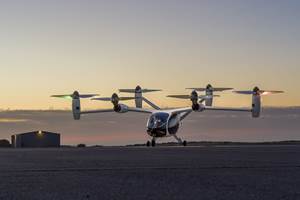The best job I ever had
Retiring CW senior editor Sara Black reflects on her almost twenty years as a writer for CompositesWorld and all she’s learned along the way.
Editor’s note: CompositesWorld senior editor Sara Black, the magazine’s longest tenured employee, is retiring at the end of February. I asked Sara, as she says good bye, to reflect on her two decades of working in and writing about the composites industry. Below are Sara’s parting words. She will be missed. — Jeff Sloan, editor-in-chief
Well, I’ve come to the end of the road here at CompositesWorld, and will be officially retired next month — although you might see my byline now and again as a contributing writer. How did nearly 20 years come and go so quickly? I got this job through a newspaper ad in the summer of 1999 and was lucky enough to figure out what “the glue and the string” meant, at least for simple applications. Eventually I was able to cobble words together in the magazine’s style. I had never interviewed anyone before, so that took some courage to do, and to learn. An early lesson: Shut up and listen and use a small pocket tape recorder, then transcribe the tape.
My first stories were about a high-performance rowing shell and the strengthening of concrete bridge columns with carbon fiber wraps. We believed those strengthening wraps were to be the next big thing in infrastructure; they did, eventually, become more widespread with time, after a learning curve. I also remember interviewing someone about a new resin that he had formulated, literally, in his own garage. This was not uncommon, I discovered; many enterprises started that way, and we only found out about their efforts through their persistence in keeping in touch with the magazine. I learned about how cultured marble was made, and what pultrusion was; one early article involved pultrusion of thermoplastics, again in a garage. Early on I was assigned an article on tooling; it took a lot of telephone time for the patient gentlemen at Coast Composites (now Ascent Aerospace) to explain to me what tooling was, how it was used to make composite parts, what an eggcrate structure meant and the definition of coefficient of thermal expansion.
I guess I came to composites just when it was starting to transition from a fragmented cottage and craftsman-ish industry into a real source of high-performance materials that was to be taken seriously. While many of the early applications I wrote about were very one-off, like a carbon fiber portable bridge for the US Army, a pultruded carbon fiber lattice structure for a wind turbine tower or a custom-built offshore race boat (using S-glass), Boeing’s 787 Dreamliner launch changed things, as did the Airbus A350 XWB. Suddenly composites seemed more important and more of an industry. I recall a Boeing spokesman giving a presentation on the 7E7 (what would become the 787) at the 2004 SAMPE in Long Beach, CA, US. I remember the room was absolutely packed but almost silent, as we learned that composites would make up more than 50% of the aircraft. Today, that aircraft design and procurement cycle is now almost over, as the Boeing NMA/797, and new versions of the Boeing 737 and Airbus A320, come forward.
Someone once remarked that a trade show was like a big reunion of all your cousins, and it did feel that way, like I knew all of you kind of well but had forgotten your names. (Please let me humbly apologize right now and say that I have always been terrible at remembering names — that’s why I was always looking at your badge.) Being an introvert, trade shows were hard for me, but I managed to make some good friends and acquaintances over the years. Some events stand out, like the Carbon Fiber conference held in Toulouse, France. I sat next to an interesting fellow there, and that led to a great story in CW on how Antonov used carbon fiber in the tails of its aircraft. And I’ll never forget the Icelandic volcano eruption during the JEC Paris event in 2010, which stranded our CW group in Paris for three days, until we mobilized to Madrid via train, with strangers helping us, to catch flights home. I returned to Madrid twice following that trip, to tour Airbus plants, as well as Carbures facilities and the MTorres campus. I also remember the hard times from 2007-2009, especially when we tried to launch CompositesWorld Expo.
It’s been a privilege to know and work with great composites champions and visionaries, and I want to thank all of you I had the opportunity to talk with and interview, who helped me create interesting and exciting stories for our readers, and make this my dream job. I wish all of you the very best.
Related Content
How composites have become a necessity
Composites used to be one of many material options across industries and applications, but that's not the case anymore.
Read MoreA return to JEC World
CW editor-in-chief Scott Francis reflects on the ways in which the composites industry has changed and also stayed the same based on observations from this year’s JEC World.
Read MoreMaking an effort to move industry forward
A reflection on the insights, connections and collaboration afforded by attending composite industry events like SPE ACCE and CAMX.
Read MoreWho's ready for the Olympics?
With the 2024 Summer Olympics in Paris, this year’s JEC World is bound to be abuzz with talk of this year’s event — from the use of composites in sporting equipment to the roles they play in AAM.
Read MoreRead Next
All-recycled, needle-punched nonwoven CFRP slashes carbon footprint of Formula 2 seat
Dallara and Tenowo collaborate to produce a race-ready Formula 2 seat using recycled carbon fiber, reducing CO2 emissions by 97.5% compared to virgin materials.
Read MorePlant tour: Daher Shap’in TechCenter and composites production plant, Saint-Aignan-de-Grandlieu, France
Co-located R&D and production advance OOA thermosets, thermoplastics, welding, recycling and digital technologies for faster processing and certification of lighter, more sustainable composites.
Read MoreVIDEO: High-volume processing for fiberglass components
Cannon Ergos, a company specializing in high-ton presses and equipment for composites fabrication and plastics processing, displayed automotive and industrial components at CAMX 2024.
Read More





















